Boat Ditching without Boundary Elements |

|

|

|

|
|
Boat Ditching without Boundary Elements |

|

|

|

|
The objective of this tutorial is to simulate Boat Ditching without Boundary Elements. So there is no boundary to represent continuous water. Basically, you are simulating Boat-Ditching in an enclosed volume. In this model, the top chamber is air (including its outer layer) and the lower chamber is water (including its outer layer). Bi-Phase material Law 37 was used to model air and water. Boundary conditions are applied on each surface of boundary in the normal direction. An interface between fluid and boat (CEL) is defined to manage the contact.
Step 1: Load the RADIOSS (Block) User Profile
| 1. | Launch HyperMesh Desktop. |
| 2. | From the Preferences menu, select the User Profiles or click the |
| 3. | Select RADIOSS (Block140) and click OK. |
Step 2: Load the boat_ditching_2.hm file
| 1. | From the toolbar, click the Open Model icon |
| 2. | Click Open. The model loads into the graphics area. |
Step 3: Define and assign Material, Property to component AIR
| 1. | In the Model browser, right-click and select Create > Material. The new material shows in the Entity Editor. |
| 2. | For Name, enter air. |
| 3. | For Card Image, select M37_BIPHAS and click Yes to confirm. |
| 4. | Input the values, as shown below. |
Remember to select ALE under ALE CFD Formulation.
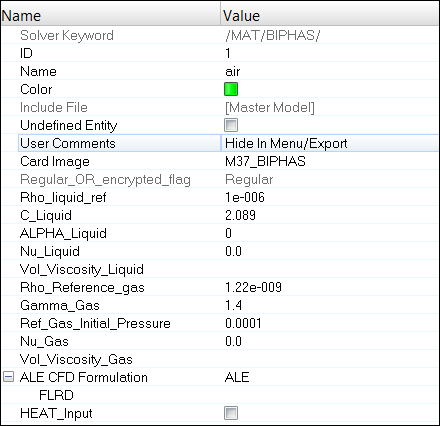
| 5. | In the Model browser, create a new property named Air with a Card Image of P14_SOLID. |
| 6. | Click on the component Air and assign as the Prop_Id and air as the Mat_Id in the Entity Editor. |
Step 4: Define and assign Material, Property to component WATER
| 1. | In the Model browser, right-click and select Create > Material. The new material shows in the Entity Editor. |
| 2. | For Name, enter water. |
| 3. | For Card Image, select M37_BIPHAS. |
| 4. | Input the values, as shown below: |
Remember to select ALE under ALE CFD Formulation.
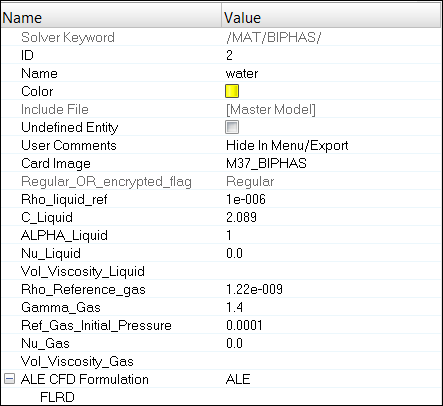
| 5. | In the Model browser, create a new property named Water with a Card Image of P14_SOLID. |
| 6. | Click on the component Water and assign Water as the Prop_Id and water as the Mat_Id in the Entity Editor. |
Step 5: Define and assign Material, Property to component BOAT
| 1. | In the Model browser, right-click and select Create > Material. The new material shows in the Entity Editor. |
| 2. | For Name, enter boat. |
| 3. | For Card Image, select M1_ELAST. |
| 4. | Input the values, as below. |
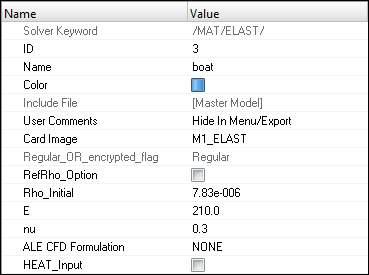
| 5. | In the Model browser, create a new property named Boat with a Card Image of P1_SHELL and assign the new property with the values shown below: |
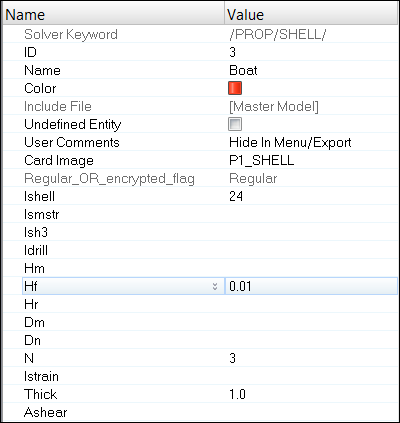
| 6. | Click on the component Boat and assign Boat as the Prop_Id and boat as the Mat_Id in the Entity Editor. |
Step 6: Define an Interface between Boat and Fluid
| 1. | Click Tools > Create Cards > ALE-CFD-SPH > INTER_TYPE18. The new interface opens in the Entity Editor. |
| 2. | For Name, enter Boat-Fluid. |
| 3. | Enter the parameter values, as shown below for Stfval and GAP. |
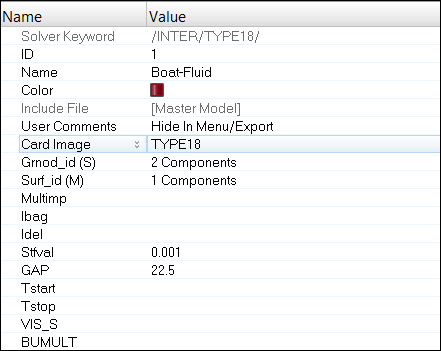
| 3. | Set the Surf_id (M) for the master selection to Components and select the boat component. |
| 4. | Set the Grnod_id (S) for the slave selection to Components and select all the components, except boat. |
Step 7: Create RBODY for the Boat and assign mass to the Master Node
| 1. | In the Model browser, isolate the boat part. |
| 2. | From the pull-down menu, select Tools > Rbody Manager. |
| 3. | For Title, enter RIGID_BOAT. Verify that the Master node is set to Calculate Node and set the Slave node(s) to Parts and select the Boat. |
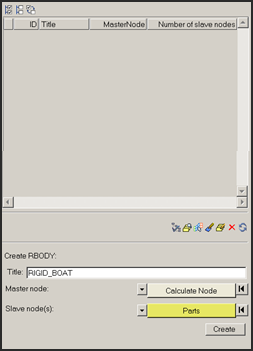
| 4. | Click Create to create the RBODY. The created RBODY appears in the table. |
| 5. | Select the created RBODY in the table and click Edit Card |
| 6. | Assign a mass of 23.04 kg to the boat. |
| 7. | Click return to return from the Card Image panel. |
| 8. | Click Close to close the RBODY Manager. |
Step 8: Create Initial Velocity
| 1. | Click BCs Manager in the Utility panel or click Tools > BCs Manager. |
| 2. | For Name, enter Boat. |
| 3. | For Select type, select Initial Velocity. |
| 4. | Set GRNOD to Nodes. |
| 5. | Click the Node tab and select the master node of the RBODY created in the previous step (ID: 690501). |
| 6. | Set Z velocity (VZ) to -11.0, indicating velocity opposite to global Z-axis. |
| 7. | Click Create to create the initial velocity boundary condition. |
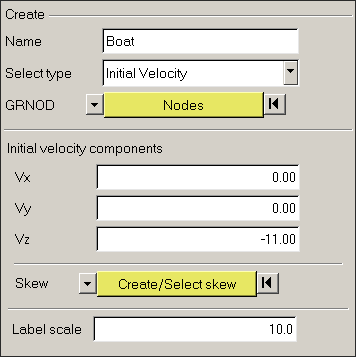
Step 9: Create Boundary Conditions on outermost faces
| 1. | In the Model browser, right-click on the Components subfolder and select Show to display all components. |
| 2. | Enter a new boundary condition in the BCs Manager, named Constraint-x. |
| 3. | For Select type, select Boundary Condition. |
| 4. | Set GRNOD to Nodes. |
| 5. | Click the Node selector and select a node on both faces normal to x-axis. |
| 6. | Click the nodes selector and select by face. HyperMesh will automatically select nodes on the face, as shown in figure. |
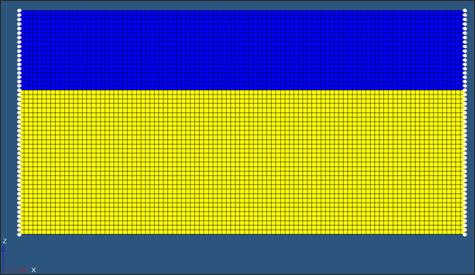
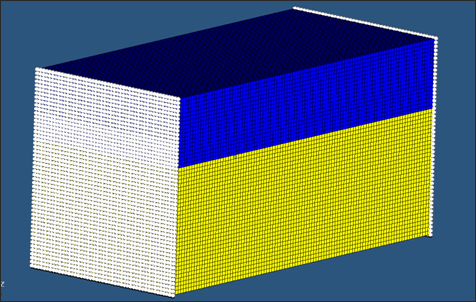
| 7. | Check Tx box to constraint translation in X direction. |
| 8. | Click Create to create the constraint. |
| 9. | Follow the same procedure (step 1-8) but create constraint in Y direction on the sides parallel to Y plane of global axis. |
| 10. | Follow the same procedure (step 1-8) but create constraint in Z direction on the sides parallel to Z plane of global axis. |
Step 10: Creating control cards and output requests
| 1. | Launch the HyperMesh Solver browser from View > Browsers > HyperMesh > Solver. |
| 2. | Right-click in the Solver browser general area to create the cards shown below with the given values for each parameter: |
Keyword Type |
Keyword |
Parameter |
Parameter Value |
|---|---|---|---|
CONTROL CARDS |
TITLE |
Status |
[Checked] |
CONTROL CARDS |
TITLE |
TITLE |
Boat-Ditch-2 |
CONTROL CARDS |
MEMORY |
Status |
[Checked] |
CONTROL CARDS |
MEMORY |
NMOTS |
40000 |
CONTROL CARDS |
SPMD |
Status |
[Checked] |
CONTROL CARDS |
IOFLAG |
Status |
[Checked] |
CONTROL CARDS |
ANALY |
Status |
[Checked] |
ALE-CFD-SPH |
ALE_CFD_SPH_CARD |
Status |
[Checked] |
ALE-CFD-SPH |
ALE_CFD_SPH_CARD |
ALE_Grid_Velocity |
[Checked] |
ENGINE KEYWORDS |
RUN |
Status |
[Checked] |
ENGINE KEYWORDS |
RUN |
RunName |
Boat-Ditch-2 |
ENGINE KEYWORDS |
RUN |
Tstop |
30.01 |
ENGINE KEYWORDS |
PARITH |
Status |
[Checked] |
ENGINE KEYWORDS |
PARITH |
Keyword2 |
OFF |
ENGINE KEYWORDS |
Status |
[Checked] |
|
ENGINE KEYWORDS |
N_Print |
-1000 |
|
ENGINE KEYWORDS |
ANIM > ANIM/ELEM |
Status |
[Checked] |
ENGINE KEYWORDS |
ANIM > ANIM/ELEM |
VONM |
[Checked] |
ENGINE KEYWORDS |
ANIM > ANIM/ELEM |
DENS |
[Checked] |
ENGINE KEYWORDS |
ANIM > ANIM/ELEM |
PRES |
[Checked] |
ENGINE KEYWORDS |
ANIM > ANIM/VECT |
Status |
[Checked] |
ENGINE KEYWORDS |
ANIM > ANIM/VECT |
VEL |
[Checked] |
ENGINE KEYWORDS |
ANIM > ANIM/VECT |
CONT |
[Checked] |
ENGINE KEYWORDS |
ANIM > ANIM/DT |
Status |
[Checked] |
ENGINE KEYWORDS |
ANIM > ANIM/DT |
Tstart |
0 |
ENGINE KEYWORDS |
ANIM > ANIM/DT |
Tfreq |
1.0 |
ENGINE KEYWORDS |
DT > DT |
Status |
[Checked] |
ENGINE KEYWORDS |
DT > DT |
Tscale |
0.5 |
ENGINE KEYWORDS |
DT > DT |
Tmin |
0.0 |
Step 11: Export the model
| 1. | Click File > Export or click the Export icon |
| 2. | For File:, click the folder icon |
| 3. | For name, enter boatditching_2 and click Save. |
| 4. | Click the downward-pointing arrows next to Export options to expand the panel. |
| 5. | Click Merge starter and engine file to export the one solver deck (or export separately). |
| 6. | Click Export to export solver deck. |
Step 12: Run the solver using RADIOSS Manager
| 1. | Go to Start > Programs > Altair HyperWorks 14.0 > RADIOSS. |
| 2. | For Input file, browse to the exercise folder and select the file boatditching_2_0000.rad. |

Step 13 (Optional): View the results in HyperView
The exercise is complete. Save your work to a HyperMesh file.
See Also: